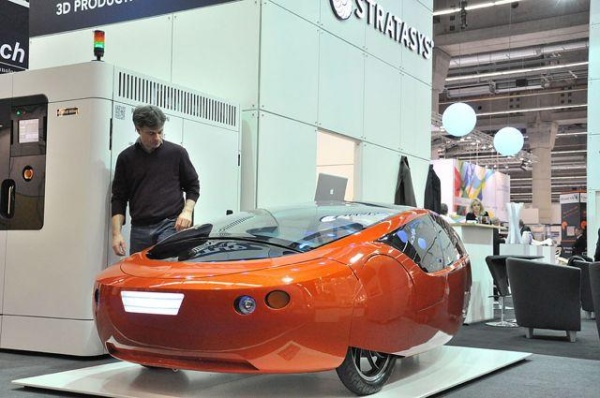 Kor Ecologic anounces that after the debut of the first prototype of a fully 3D printed car, the Urbee, it is now ready for production.
Kor Ecologic anounces that after the debut of the first prototype of a fully 3D printed car, the Urbee, it is now ready for production.
Over the last years the company has been developing a follow-on model, the Urbee 2.
Urbee is designed to be environmentally sustainable. This is because it can efficiently store and use exactly the amount of solar and wind energy you can collect on a one-car garage in one day. If you want to go farther in a day, you can use its ethanol powered engine.
The Urbee design team had a vision. That vision was written out and posted on the walls of our shop. It is the fundamental design ideals we followed in working on the Urbee Car Project.
Use the least amount of energy possible for every kilometre traveled.
Cause as little pollution as possible during manufacturing, operation and recycling of the car.
Use materials available as close as possible to where the car is built.
Use materials that can be recycled again and again.
Use parts and materials that last as long as possible.
Be simple to understand, build, and repair.
Be as safe as possible to drive.
Meet the standards and regulations applicable to traditional cars.
Be buildable in small quantities so we don't have to wait for it to become more widely accepted before we can begin manufacturing it for the public.
Be mass-producable so it can be built more economically once it becomes more widely accepted.
Be affordable.
Be visually appealing.
There is much about Urbee that is highly innovative. However, the innovation does not lie in expensive 'start-of-the-art' technology, the use of expensive materials, or complicated manufacturing processes. Urbee's innovation is that it uses widely available materials and components in original ways.
The designers of Urbee have attempted to maximize the distance that can be traveled per unit of energy consumed by minimizing seven important properties of the car: weight, coefficient of aerodynamic drag (Cd), rolling resistance (Crr), frontal area, maximum speed, maximum acceleration.
COEFFICIENT OF DRAG
The Coefficient of Drag (called "Cd") for a vehicle is one of three things that affect how much energy is required to overcome aerodynamic resistance. It is a number that describes the 'slipperyness' of a shape as it passes through the air. Urbee is being designed to have a Cd about half that of a traditional sports car.
COEFFICIENT OF ROLLING RESISTANCE
We have attempted to make the coefficient of rolling resistance of Urbee as low possible by using large diameter motorcycle tires inflated to high pressure. As well, the cross sectional profile selected for the tire has a very small contact surface with the road.
FRONTAL AREA
The frontal area of a vehicle is approximately equal to its width multiplied by its height. We decided to make the roof of Urbee as low to the ground as the lowest production car ever made, the Ford GT-40, which was 40 inches above the ground. We also tried to minimize the width by placing the two occupants as close as comfortably possible to each other.
MAXIMUM SPEED AND ACCELERATION
By reducing the maximum speed and acceleration of Urbee compared to what many other cars are capable of, we can dramatically reduce the maximum horsepower required to power our car. The smaller motor/engine size in turn decreases the weight of the vehicle and increases the range.


















































































